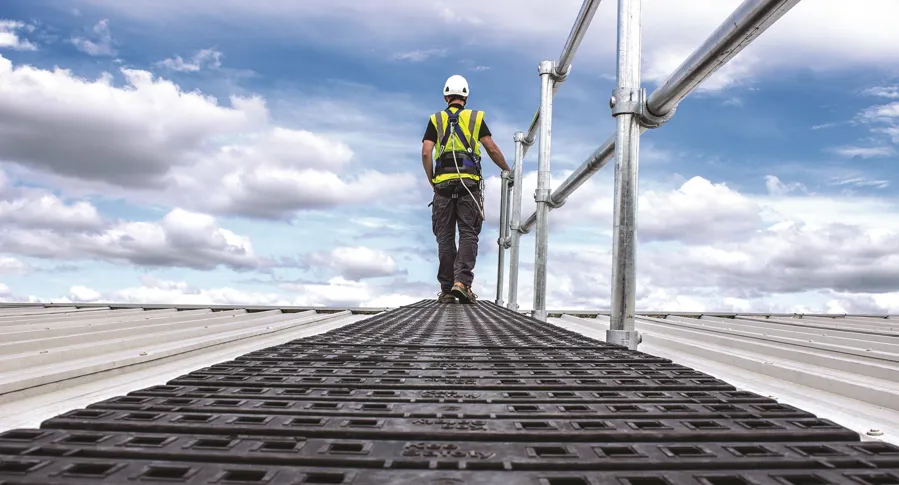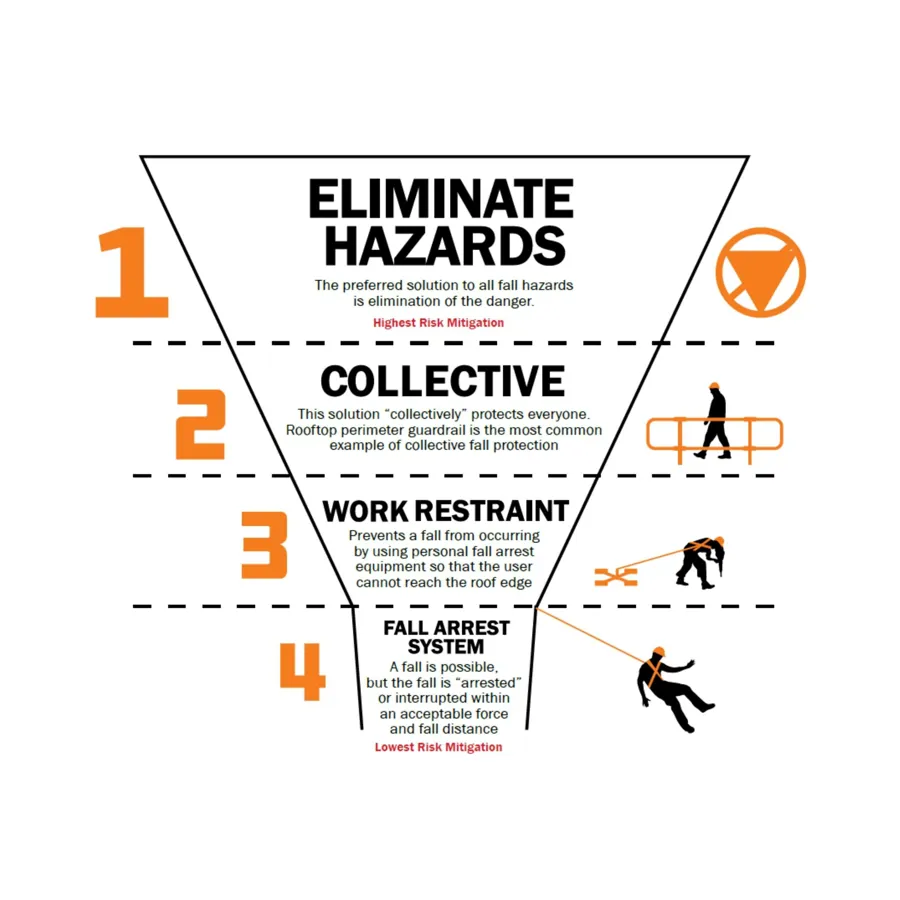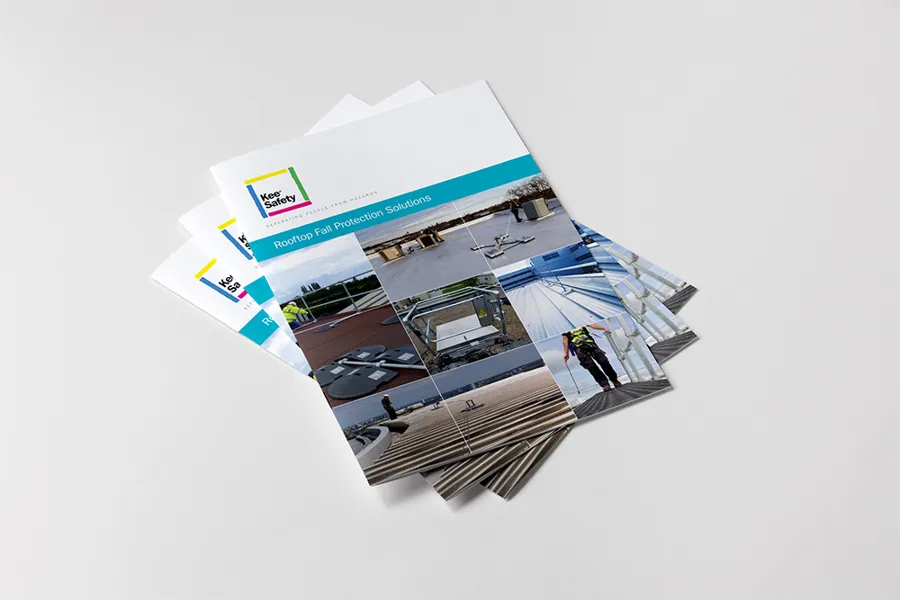
You are visiting the Canada Kee Safety website from United States. Would you like to go to the United States site?

Ask a typical person on the street what the difference is between passive and active, and the response will probably relate to lifestyle.
“A passive person sits on the couch and watches TV, but an active person is out jogging and exercising.”
Ask a worker on a rooftop what the difference is between passive and active fall protection, and the answer would be counterintuitive to lifestyle choices.

In the Hierarchy of Fall Protection —(1) eliminate the hazard; (2) collective barrier; (3) fall restraint; (4) fall arrest—Passive Fall Protection is the preferred method of safeguarding workers at height.
Although passive is considered advantageous, the roof configuration may not make it possible or practical. It is ultimately up to the facility/safety manager or another responsible administrator to understand the difference between passive and active fall protection and then implement the best solution for the facility.
Like the person just sitting on the couch doing nothing, the rooftop worker does not have to do anything to be protected by a passive fall protection system.
A building constructed with a parapet of sufficient height (at least 42”) or that has a perimeter railing system that meets regulatory standards is thus protected. The worker does not need a harness or any other fall restraint device when up on the roof.
The fall protection system is already in place and will always be there for workers to perform their tasks. Workers not having to do anything defines the fall protection system as passive. (Since several workers are protected at once, a railing system is also known as “collective” fall protection.)
The most common passive rooftop fall protection type is a modular perimeter guardrail system for a flat or low-slope roof. It can be custom designed to meet the roof configuration and, in the case of Kee Guard®, does not penetrate the roof membrane. A railing system can be permanent, or a set of temporary rails set up and removed when needed, such as Kee Guard® Safety Railing for Narrow Rooftop Spaces.
Skylights and roof hatches also require fall protection. Data compiled by regulatory agencies attest that falls through skylights are more common than falls over roof edges. Skylights may look solid and secure, but they are holes in the roof and not always as safe as they appear.
Passive fall protection for skylights can be a safety railing system around the skylight, such as Kee Dome®, or a screen that attaches to and fits over the skylight, such as Kee Cover®. For roof hatches—obvious openings in the roof—railings such as Kee Hatch® (with a self-closing safety gate) provide appropriate fall protection.
Sloped, standing seam, and other types of roofs may require walkways with railings to provide passive fall protection. Obstructions and trip hazards on roofs—piping, change in level—can be protected (passively) by “cross-over” steps with railings.
For that energetic person striving to stay in shape, using active fall protection could be surprisingly rigorous.
An active fall protection system directly involves the worker when providing fall restraint and/or fall arrest. It is preferred for confined spaces, high slopes, or vertical areas, or wherever a guardrail or other passive system is not possible or practical.
Active devices and equipment include harnesses, lanyards, anchors, lifelines, and connectors. A term used for these fall restraint and fall arrest systems is “tie-off.”
A full-body harness needs to support a weight of at least 310 lbs. (worker and tools) and be secured to an anchorage and deceleration device that limits the impact force of a fall to 1800 lbs.
Lanyards connect the harness with the anchorage. They can be shock-absorbing, self-retracting, or fixed-length positioning.
Anchorage points are designed to withstand nearly 5000 lbs. or double the load of a person falling approximately 6 feet.
Kee Line® is an example of a horizontal lifeline for rooftops. Kee Anchor® is a mobile deadweight anchor tie-off system, and Kee Post® provides fixed tie-off points for lanyards and harnesses.
The design, purchase, and installation of a passive roof perimeter railing system can be a significant investment, but it is usually a one-time cost. Workers and others accessing the rooftop need no special training or equipment to be protected. If constructed with durable, corrosion-resistant materials, passive systems require virtually no maintenance.
Although anchorages may be a one-time investment, other active fall protection systems, such as lifelines and harnesses, are only a first step. Workers must be adequately (sometimes repeatedly) trained in using these devices. The equipment should be inspected before and after every use, and components are subject to wear and tear – requiring replacement.
Although passive systems are considered more desirable, the manager or administrator responsible for rooftop safety should take an active approach to evaluating the company’s rooftop needs and safety solutions.

A truly comprehensive rooftop solution follows the Hierarchy of Fall Protection. An expert starts by inspecting the roof site for potential fall hazards. From there, a complete system solution and recommendations are created that descend down the four levels of the hierarchy, from simple, sensible approaches for eliminating risks all the way down to lifesaving personal protection systems.
Collective Systems require no additional training to use. Fall Restraint and Fall Arrest Systems both require a high level of user competency, training and additional inspection to be used properly.

Kee Safety: Your Fall Protection Experts
Kee Safety is the world’s leading fall protection expert. We engineer, manufacture and install fall protection solutions that safely separate people from hazards. Our OH&S-compliant products and systems are third-party tested and trusted to ensure consistent performance at the highest level.